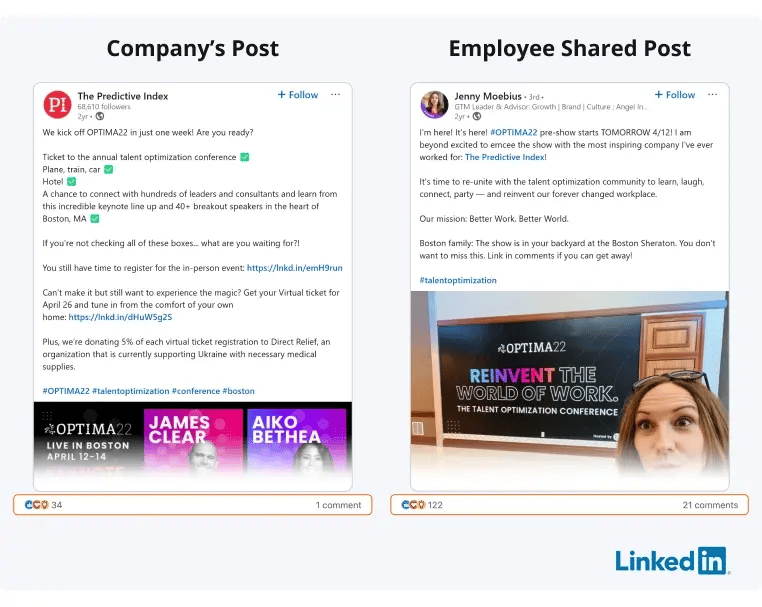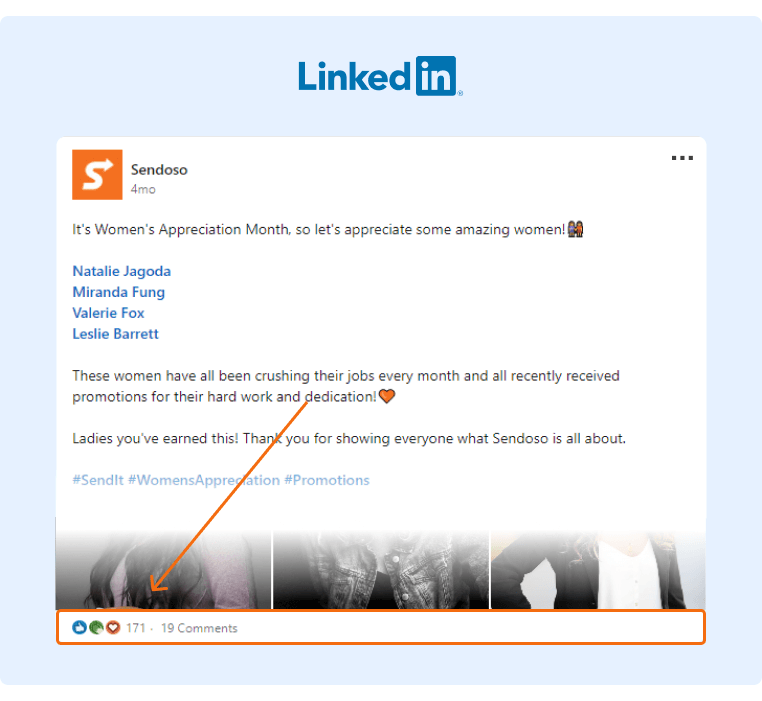10 LinkedIn Post Examples for Awards, Updates & Wins
There are plenty of different ways to optimize LinkedIn content (e.g., use the right hashtags, post consistently, post at the right time, etc.).
All of that is important.
However, despite following these best practices, plenty of brands still find their content generates subpar engagement.
The typical response is, "well, you just have to keep posting consistently, and eventually, your engagement will improve."
However, that doesn't seem to be true.
To explore this hypothesis, we studied 30 companies from the Fortune 1000 list. The average company posted 3.8 times per week, and the average post only generated 1.7 comments and 4.8 shares. However, some brands have a modest LinkedIn audience and consistently generate excellent engagement.
 For example, Tata Technologies is an engineering company, and the engagement on this post is good – but not abnormal – for their brand:
For example, Tata Technologies is an engineering company, and the engagement on this post is good – but not abnormal – for their brand:

So in this post, we'll break down specific LinkedIn posts from top-performing brands and uncover exactly what they're doing differently from everyone else. The best part? It doesn't involve posting content five times a day or waiting ten years for your follower count to grow.
Tackling The Low Hanging Fruit
While I mentioned above that just optimizing your strategy probably won't unlock explosive growth, it is still important to have a solid foundation that you can build on. Specifically, be sure to:
-
Optimize your company page
-
Craft outstanding content
-
Set up an employee advocacy program
Let's briefly discuss each of these points.
Optimize Your Company Page
You already know the basics of filling out your LinkedIn profile, like adding high-quality images, so here are a few pro tips to improve your LinkedIn page.
First, add relevant keywords to your summary and overview to make it SEO friendly. This will help relevant LinkedIn users find it and boost your visibility in traditional search engines like Google.
In addition, if your brand offers a SaaS or eCommerce product, you can add products (along with a product video) to help people quickly understand your offer.
 LinkedIn also enables you to add a custom CTA to your company page. So now you can drive people directly to a demo signup page or send them to an informational page to learn more.
LinkedIn also enables you to add a custom CTA to your company page. So now you can drive people directly to a demo signup page or send them to an informational page to learn more.
 In addition, ask your employees (especially your executives) to update their profiles as most people looking at your company will probably also view some of the employees' profiles.
In addition, ask your employees (especially your executives) to update their profiles as most people looking at your company will probably also view some of the employees' profiles.
Craft Outstanding Content
Rather than staring at a blank page and trying to think of compelling LinkedIn post ideas, here are a few common themes we've seen across the top-performing content:
-
It includes a humanistic element: This could be a case study of how your product/service significantly impacted a user's life. If your product/service isn't necessarily life-changing, you can share an experience or something the brand is doing for the community.
-
It takes an original stance on the topic: If one of your executives posted a piece of thought leadership content, consider reposting it on the branded company page. You could also interview an executive to get their take on a piece of industry news and then write a post for the brand's page.
-
It contains a visual asset: As people scroll through their news feed, visual content (like a video, infographic, template, or screenshot) can grab their attention and get them to pause on your post. While there isn't one specific type of content that performs best, experiment with different formats and see what resonates with your audience.
In the examples below, you'll see all three of these frameworks at play, so keep reading for more examples!
Create an Employee Advocacy Program
Finally, you've probably noticed that the LinkedIn algorithm gives posts with good initial traction more organic reach. So if LinkedIn shows your post to a handful of people and they scroll past it, the algorithm will probably give it less organic reach.
Fortunately, you can also use this to your advantage.
If a handful of your employees engage with a post when it's first published, the LinkedIn algorithm will take that as a positive signal and give it more reach.
In addition, you'll get more organic reach when your employees re-share the content with their social networks.

So as you'll notice throughout the examples below, all of them used employee advocacy to gain some initial traction before the posts took off on their own.
Now that you have a solid understanding of the basics, here are some of the best LinkedIn post examples we could find.
Example #1: Award Announcement
Key Stats
Likes: 203
Comments: 5
Shares: 29
In this post, CPaaS company Vonage announced an award they won. So while the content itself wasn't incredibly creative, it was well optimized and the strategy they used to promote it was effective enough to make it a huge success.
Analyzing it from an optimization standpoint, they used a custom short link (which is a recommended LinkedIn best practice). They also created an appealing, visual graphic rather than using the featured image from the press release.
To promote the post, they used GaggleAMP to deploy an employee advocacy strategy (asking their employees to engage with it).
The CEO himself engaged in the comments, and his comment alone received 39 likes.
Pro Tip: If you're struggling to get executives to engage with your content, GaggleAMP makes it possible for you to pre-write text for them directly inside the activity assignment.
Example #2: Feature Release Announcement
Key Stats
Likes: 640
Comments: 4
Shares: 133
Elastic is a platform for search-powered solutions, and one of its most successful social media posts is a feature release announcement.
Rather than just linking to a blog post, they created a quick video summarizing the new feature. If you want to create a similar video, you could hire someone on a platform like Upwork.
In addition, they included a shortened URL to the full blog post (rather than using the full URL).
To drive more engagement, Elastic deployed an employee advocacy strategy (using GaggleAMP) and requested employees to engage with the post.
This gave it the initial traction necessary to get the word out and then you can see that it naturally generated plenty of engagement from customers and potential customers:

Example #3: Employee Story
Key Stats
Likes: 757
Comments: 24
Shares: 31
Stryker is a medical equipment manufacturer, and one of its most successful social media posts was an interview with an employee. LinkedIn is first and foremost a social media platform, so showcasing one of its employees adds a humanistic element to the post, making it much more shareable.
In addition, Stryker chose to create a video rather than just a text-based post, which is often more engaging. The video also uses a branded frame and has subtitles to encourage viewers to pause. If you want to add a similar frame to your videos, you can use a tool like Animoto.
It also includes three hashtags (two of which are keywords, and one is a branded term), and the URL is also shortened.
As you can see, the post is well optimized and follows classic social media best practice advice, though what really pushed it to be successful is that they used employee advocacy to promote it. Once employees started sharing it, the post picked up plenty of organic traction, and the engagement snowballed.
Example #4: Breakthrough Accomplishment Announcement
Key Stats
Likes: 1,469
Comments: 109
Shares: 162
Archer is a San Francisco-based aerospace company building all-electric vertical takeoff and landing aircraft. So when they achieved their first hover flight test, it was a perfect opportunity for a LinkedIn post.
For this post, they created a high-quality, professional video that included clips of interviews with the founders, footage of the preparation, and the actual test flight.
So it's no surprise that the post was a huge success. To further promote the post, they also leveraged employee advocacy. As employees pushed the post to their network, it quickly picked up traction and attracted the attention of highly influential figures, including other C-suite executives and industry leaders.

Example #5: Feature Release Announcement
Key Stats
Likes: 108
Comments: 3
Shares: 27
TripActions is an all-in-one travel, corporate card, and expense solution that recently released a Well-Being dashboard. To promote the new feature, they created a screen video of the feature in action and added a compelling post (with statistics) to explain the pain point the new feature solves.
It also includes five relevant hashtags and the link to the blog post is a shortened URL.
To help it achieve maximum reach, they also used employee advocacy to promote the post to the employee's followers.
Example #6: Partnership/Culture Enhancement Announcement
Key Stats
Likes: 606
Comments: 10
Shares: 6
Amadeus is a travel company that recently announced a partnership with Goodwatt, a business supply company. The partnership enables Amadeus's employees to ride electric bikes to work, so it shows off some of its employee benefits and shows that it's an environmentally conscious company.
Culture-focused and sustainability posts tend to perform, so by combining both themes into one post, the content was well positioned for success.
As you can see from the comments, it clearly struck a chord with the audience.
 In addition, they added several photos of their employees using the bikes, which adds a humanistic element to the post.
In addition, they added several photos of their employees using the bikes, which adds a humanistic element to the post.
Finally, they also used employee advocacy to boost the post's reach, and because the content itself was already well-liked, it didn't take much for the post to pick up traction. As you can see from the comments, most of the engagement was from non-employees.
 Example #7: Employee Success Post
Example #7: Employee Success Post
Key Stats
Likes: 171
Comments: 19
Shares: 1
Sendoso enables companies to send personalized gifts, branded swag, eGifts, and virtual experiences.
For Women's Appreciation Month, they created a post highlighting a few women in their company who recently received promotions.
Posts that highlight employee wins naturally tend to succeed as their friends also want to support them.
In addition, it's a great recruiting tactic as it openly shows that Sendoso really cares about its employees.


Example #8: Client Success Story
Key Stats
Likes: 510
Comments: 43
Shares: 7
Client success stories naturally tend to perform well, but when they discuss the impact a company had on a person's life, it can turn into a home run. This is exactly what happened when Bright Horizons, an education management solution, posted a heartwarming story about one of their customer's successes.
By making the post about the customer (and including heartwarming images that showed the impact of this achievement), people are naturally inclined to engage. You can also tell that it looks more like a typical post celebrating a friend than a branded promotional post.
They also boosted engagement by using employee advocacy to spread the word.

Example #9: Recruiting Post
Key Stats
Likes: 427
Comments: 24
Shares: 82
Tata Technologies is a global product engineering and digital services company that recently hired about 80 electric vehicle engineers. To promote the opportunities, they created a LinkedIn post with the details.
This post itself was fairly simple – it includes many hiring-related hashtags and a flier with a basic description of the opportunity.
However, there are a handful of reasons why it probably performed well:
-
People are willing to share career opportunities as it is genuinely helpful to their networks
-
They used employee advocacy to generate more reach
-
They respond to almost all of the comments, which helps it gain more traction organically (and encourages people with questions to comment)


Example #10: Philanthropic Post
Key Stats
Likes: 283
Comments: 9
Shares: 8
If your company has done any kind of philanthropic work, create a LinkedIn post about it! Philanthropic posts naturally tend to perform well because people want to support positive initiatives.
So when IT consulting company, EXL, posted about its work providing IT needs for underprivileged schools in India, it's no surprise that the post performed very well.
The post itself was relatively simple, though it included several pictures of the school using the new equipment, which added a humanistic element to the post.
They also used employee advocacy to push the post to as many people as possible.
 Skyrocket Your LinkedIn Post’s Engagement
Skyrocket Your LinkedIn Post’s Engagement
Hopefully, this post gave you some content ideas for your next LinkedIn post.
Though before you start crafting new content, I think it's worth noting that all of these posts had one thing in common – they all used employee advocacy to gain traction.
Employee advocacy is a simple way to get more organic traction with minimal additional effort on your part.
However, if you've ever tried to start an employee advocacy campaign, you've probably realized that just asking people to share the brand's content is minimally effective. After all, it's a burden for them to log into their social media platforms, select a post, and then decide what to say (if they comment or share – which are more powerful engagements than likes).
In addition, it's not really feasible for you to track who is engaging and the impact (total reach, estimated earned media value, etc.) of your employee advocacy strategy.
GaggleAMP solves these problems. Specifically:
-
You can assign a specific engagement action (like, comment, share) for a particular post to specific employees (or groups of employees) – in just a few minutes.
-
Employees receive a notification when you assign a post and they can complete the engagement actions directly inside the Gaggle. They can also schedule their engagement actions to go live throughout the week.
-
You have a full analytics dashboard that shows you exactly which employees are most active, as well as post statistics like estimated earned media value (EEMV), total reach, and more.
To learn more about GaggleAMP, schedule a demo, or you can go ahead and try it out for free today!












